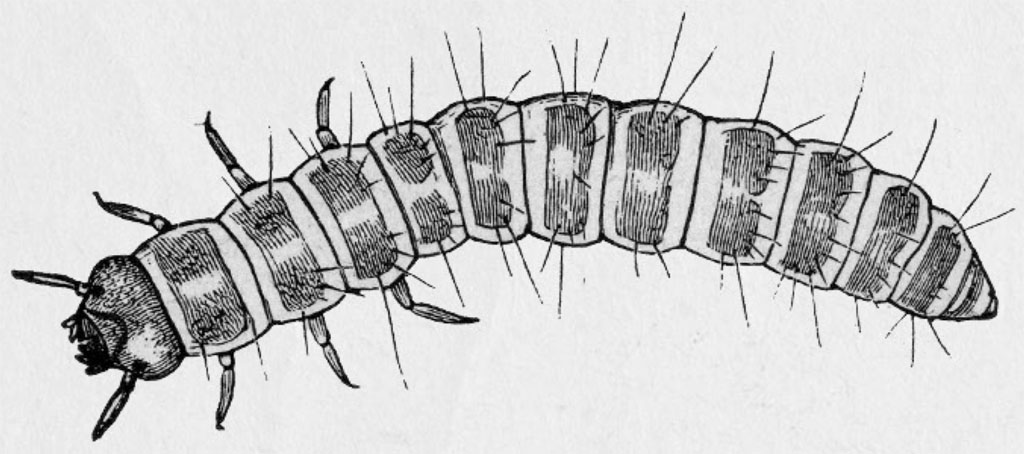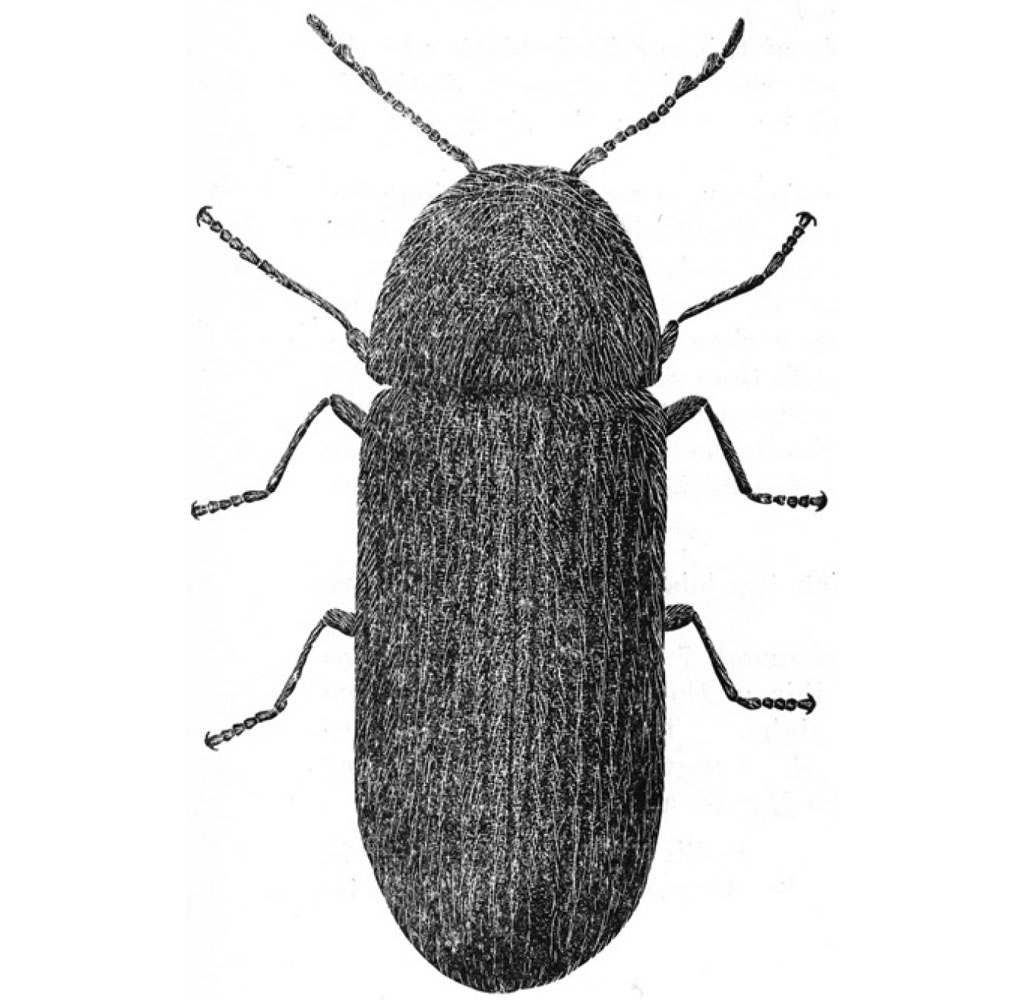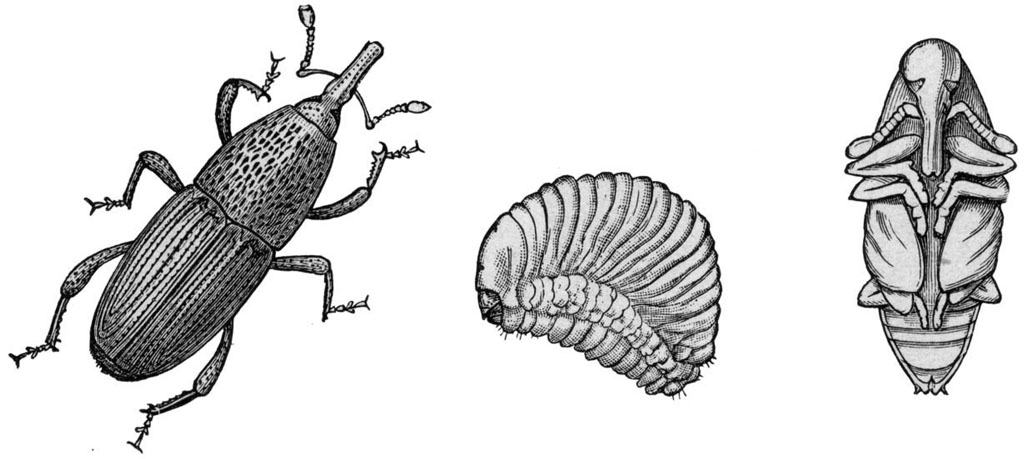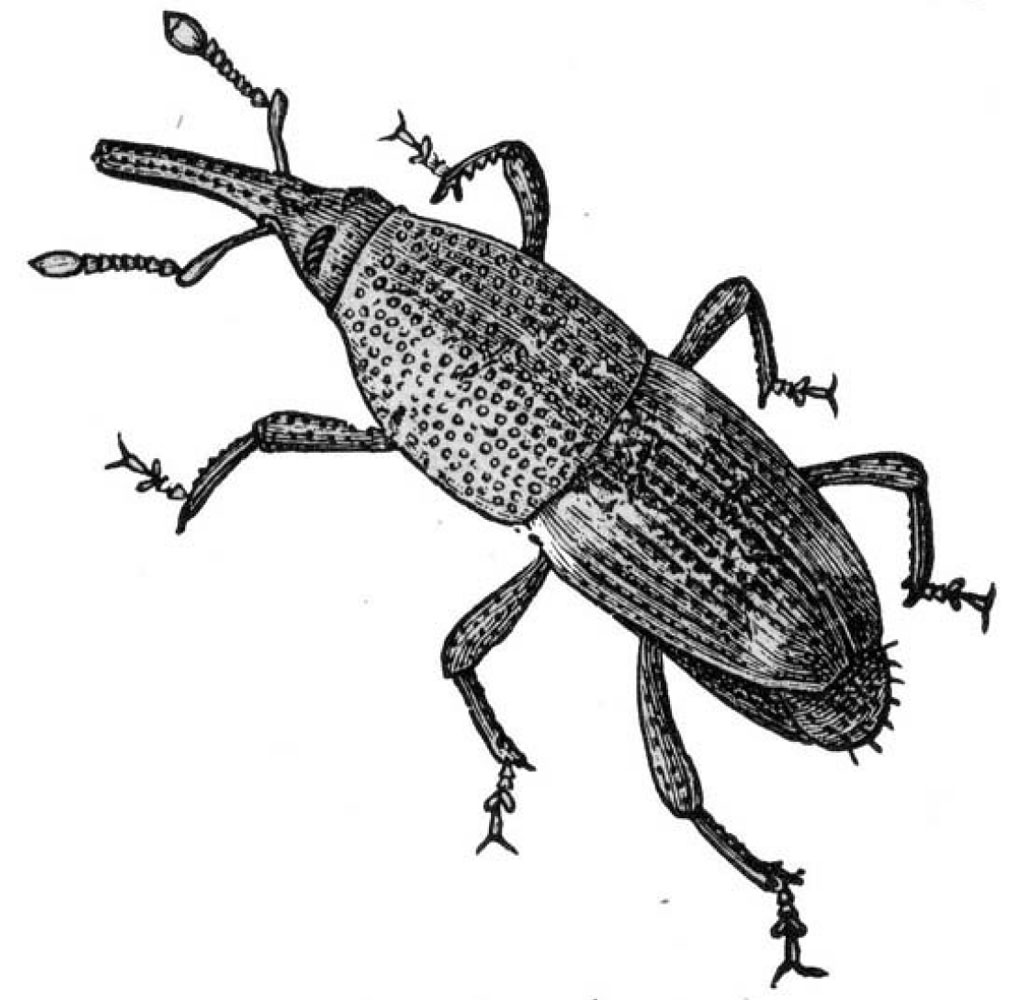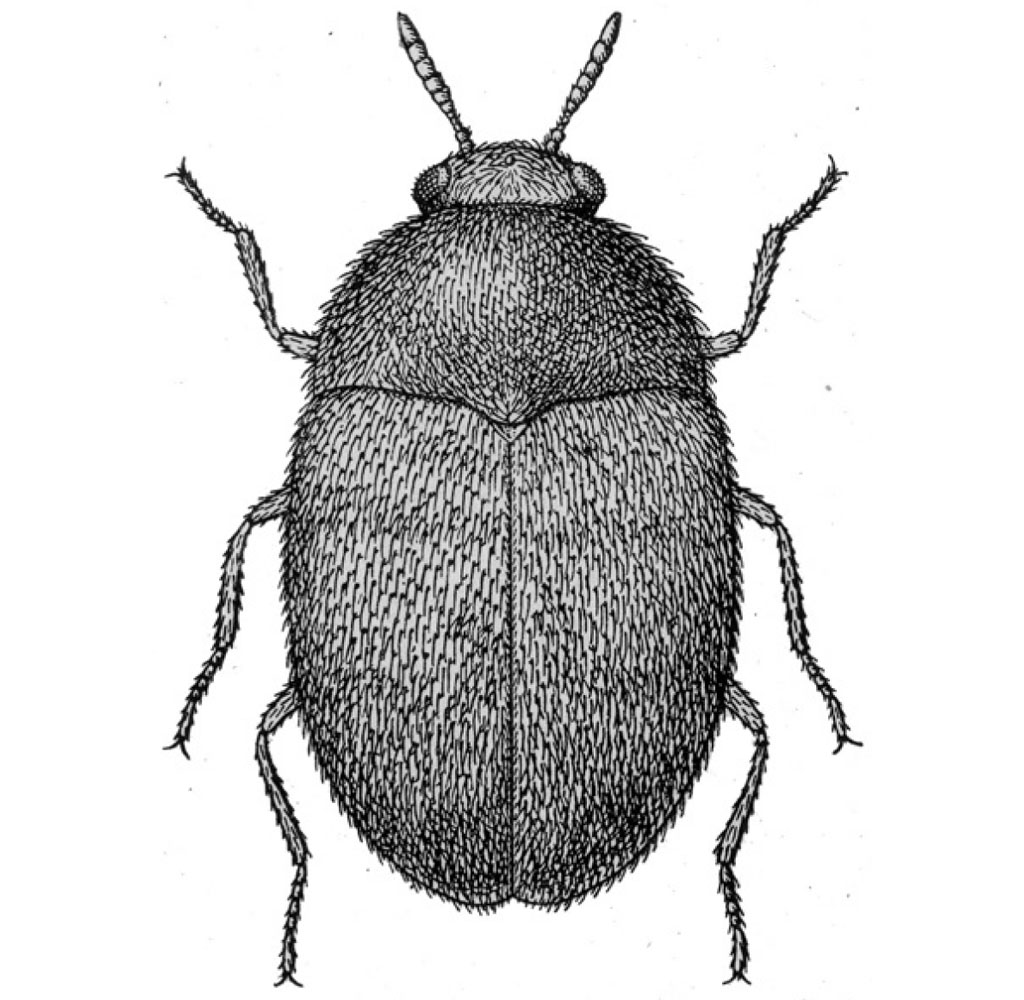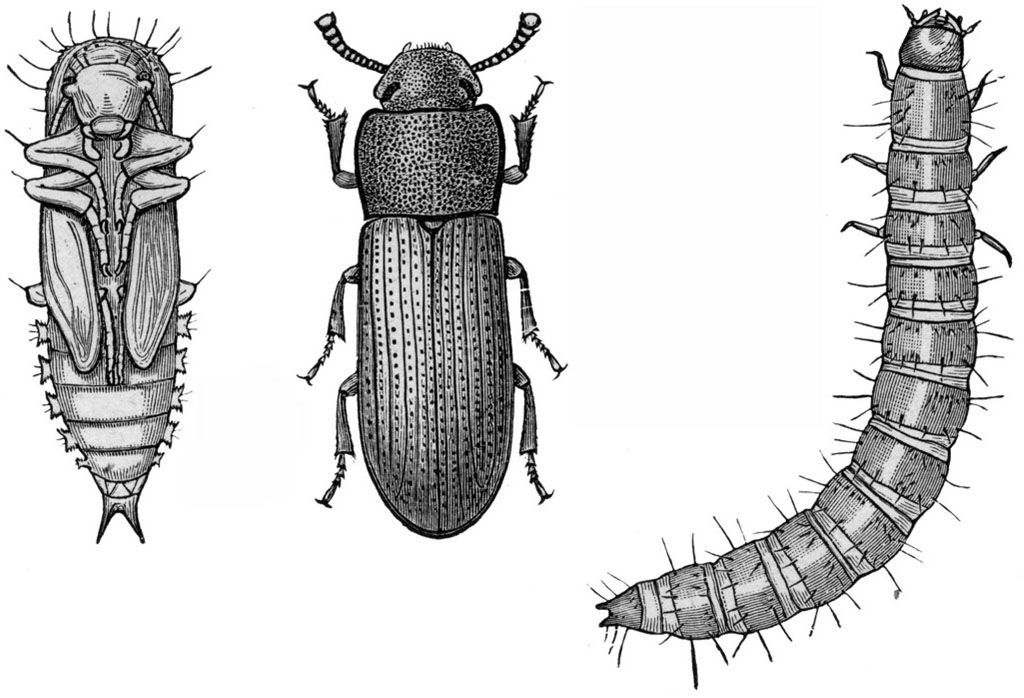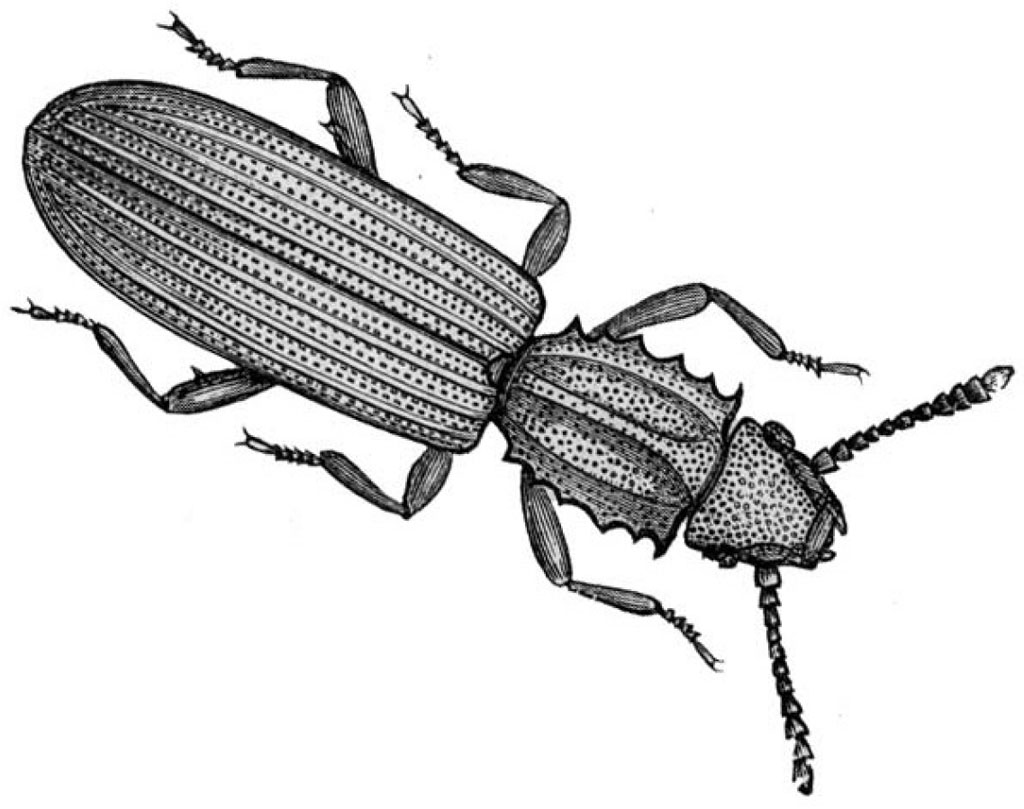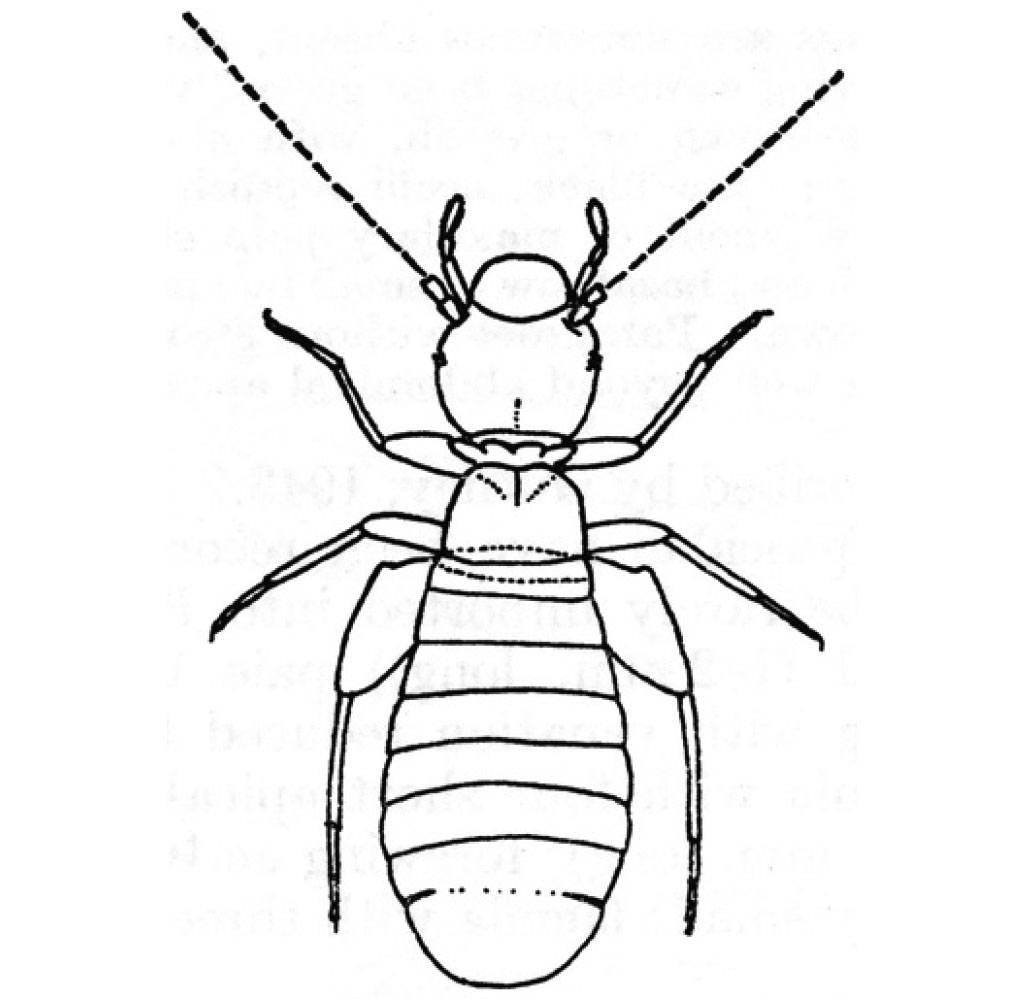WAREHOUSE, LARDER AND PANTRY
Many years ago, while looking for insects in an invertebrate survey alongside London’s River Wandle, near its outflow into the Thames in densely urban Wandsworth,
south London, I scooped out and sieved some old pigeon-nest material from underneath the metal and concrete bridge arches where the river passed under the busy South Circular Road. Along with
some bird fleas, a few predatory bugs and general detritivore fly larvae, I found numerous tiny, pale, cylindrical beetles. These were biscuit beetles Stegobium paniceum, but they were
not feeding on biscuits.
The first time I ever found biscuit beetles, they were floating to the surface of the milk I was pouring onto my breakfast cereal. I regarded the first two or three with
bemused curiosity, but by the end of the week I decided to go on a biscuit beetle hunt to root them all out. They were not just in my cereal; they were in the flour (plain and self-raising), cheese
crackers, noodles (which looked like ticker tape), lasagne sheets, sugar, pine kernels, sesame seeds, dried beans and cat biscuits, and in the beef-stock cubes, having chewed their way through the
tight-fitting metal-foil wrappers. They were everywhere, in fact, necessitating an almost compete clear-out of the shelves, apart from the tinned food.
One or two beetles in my breakfast cereal was neither here nor there, but others have complained about the beetles more earnestly. It may have been this species that naturalist Joseph Banks
wrote of during his voyage to the southern hemisphere with Captain Cook. In his journal of 1769 (quoted by Buckland 1981) he wrote:
Our bread is but indifferent, occasioned by the quantity of vermin that are in it. I have seen hundreds, nay thousands, shaken out of a single biscuit [loaf]. We in the
cabin have, however, an easy remedy for this, by baking it in an oven, not too hot, which makes them all walk off; but this cannot be allowed to the ship’s people, who must find the taste
of these animals very disagreeable, as they everyone taste as strong as mustard, or rather spirits of hartshorn [ammonia].
The variety of the biscuit beetle’s infestations in my poorly maintained food cupboard does not make it a thoroughly generalist feeder. As its common name suggests it was
traditionally found mostly in biscuits, or taking into account its scientific name, paniceum, also in bread (Latin panis). The common denominator is, of course, wheat, which is a
major ingredient (or a minor one in the case of stock cubes) in so many foodstuffs these days. Of course, it will try anything with starch in it, and has made itself a nuisance in such odd
substrates as spices, cocoa beans, liquorice, paper and wooden mah-jongg pieces (it is closely related to woodworm beetles). It is sometimes (especially in North America) called the drugstore
beetle, because of its pest status in pharmacies, where it eats stored pills including those containing strychnine, but this is because the major ingredient in any given tablet is the
‘filler’ made of starch and whey. Wheat is the key nutrient.
Back under the road arches by London’s River Wandle, there were no wheat products available. My first thought was that the beetles may have been breeding in scraps of bread brought back to
the feral pigeons’ nests, but the ravenous birds had eaten every crumb. The ragged nest heaps did, however, contain sheaves of grass stems, complete with very many small grass seeds, in
plentiful abundance. Wheat is, after all, a grass – it has much larger seeds than our wild grasses, expanded by thousands of years of selective breeding, but it is a grass nevertheless. Here
was a notorious kitchen pest feeding on its original natural food, in the wild.
Wheat is everywhere now, and the biscuit beetle serves as a useful paradigm for trying to understand where grain pests originated, and how they came to invade the pantry in the first place.
There are several variations on this theme.
THE HUMAN LOVE AFFAIR WITH CEREALS
Wheat Triticum aestivum is arguably the basis of Western civilisation. It was the cultivation of wheat that transformed nomadic, part-time amateur smallholders into the
settled farmers of the Fertile Crescent, resulting in the flourishing of prehistoric cultures such as the Assyrian kingdom and the Egypt civilisation. The initial domestication event is reputed to
have occurred somewhere in what is now south-eastern Turkey at least 9,000 years ago. Other cereals are also implicated in the very earliest agriculture hereabouts, including spelt Triticum
spelta, emmer Triticum dicoccum, einkorn Triticum monococcum and barley Hordeum vulgare.
The appearance of these relatively large grass seeds in the area of the eastern Mediterranean, north-east Africa and Western Asia, now referred to as the Fertile Crescent (also the Cradle of
Civilisation), is nothing short of miraculous, but the miracle was not god-given – it was weather related. One of the latest suggestions from palaeobotanists (for example Hole 1992) is that
the large grass seeds developed as an evolutionary response to the end of the last ice age, some 15,000 years ago. As the world warmed and the northern ice sheet retreated, local weather patterns
were altered and the climate of the area changed from constantly moist subtropical to seasonally dry subtropical.
Seeds are a plant’s cold- or dry-season insurance policy, adapted to remain dormant, waiting for the right temperature or soil moisture, for months or years (many survive for centuries).
Some plants gamble on success by going for quantity, producing thousands of tiny seeds (this is the way orchids have evolved), but for the grasses of the Near East, larger seed size was the
strategy that worked best. For the people living in this area it was a godsend, and humans have never looked back.
Exactly how or why cereal-based agriculture first happened is, however, lost in the dusty murks of antiquity, beyond almost all conjecture. For one thing, even though the archetypal wild cereal
seeds grew larger, all those millennia ago, they were still smaller than modern wheat varieties, so that the early farmers must have been scrabbling around for fairly mediocre grains when they
first foraged any scattered seeds or harvested their first crops. Grasses themselves have never been a human foodstuff, and are indigestible in the human gut, even when cooked. There are endless
theories.
One of the more quirky theories is the suggestion that early foragers raided ants’ nests to get at the grain stores. The Mediterranean and Middle East are home to harvester ants,
Messor and other species; these large, heavily built black ants have massive heads, all muscle to power the jaws they use to carry seeds and hulls many times their own body weights. They
drag mostly grass seeds back to the subterranean nests and store them in underground granaries. By biting off the radicle (the embryonic root), the ants prevent the seeds from germinating, and
since the evolutionary purpose of seeds is to remain dormant for months or years until suitable growth conditions reappear, these energy-rich, high-protein packages make the perfect food-storage
option. This rationale also works for humans.
Harvester ants fascinated the ancients, almost to the exclusion of the many more numerous non-harvesting species. Aristotle, Pliny, Aelian, Plutarch and Virgil all comment at length on the
single-minded activity of these marvellous tiny creatures (Beavis 1988). They and plenty of others draw strong moral parallels with the ants, urging tireless and industrious cooperation over
shirking lethargy (Aesop is particularly well known for this). In a prehistoric society collecting ant-seed caches might have seemed just as natural as taking honeycomb from a wild bees’
nest.
Another interesting idea is the notion that wheat (or barley) was first used not to make bread, but to make beer (McGovern 2010). Often safer than drinking stream water, low-alcohol (by
today’s standard) beverages made from fermented cereal grains would be mostly free of bacteria and other micro-organisms. Depictions of beer drinking, and recipes and poetry extolling
beer’s virtues, are known from ancient Egypt (3500 BC) and China (7000 BC).
Whatever came first, the bread or the beer (or the biscuits even), cereal grains transformed human society. And if it wasn’t wheat, it was millet (in Africa), rice (Oryza sativa,
in monsoon Asia) and maize (in the warmish tropical hills of Central and South America), followed by oats and rye in cooler northern Europe. Whatever the proto-farmers did with it, the most
important aspect of cereal agriculture was that the surplus grains could be stored for many months to feed the populace outside the initial seasonal harvest glut. Grains could also be moved without
them going off in transit, and they could be traded.
All this worked well, as long as the grains were kept dry so they did not start germinating prematurely, and as long as they could be protected from grain pests.
GRAIN PESTS – THE ANCIENT EGYPTIANS PROBABLY HAD A WORD FOR THEM
Despite their pre-eminent place in our cultural understanding of antiquity, we actually don’t know much about what the Ancient Egyptians called their grain pests. They
certainly had them, and there are plenty of entomological reports from archaeological digs – Blair (1935), Panagiotakopulu (2001), Panagiotakopulu and Buckland (2009). Much to the chagrin of
Italian entomologist Anastase Alfieri, his discovery of several beetles in the foods laid out for the afterlife in the tomb of Tutankhamun were considered insufficiently interesting by Howard
Carter, who refused to include them in his monograph on the boy king. A disappointed Alfieri had to publish his results elsewhere (Alfieri 1931).
We do, however, have written records from the Assyrian metropolis of Nineveh – the Har-ra (or Hubullu) tablets, cuneiform texts excavated in the 19th century from the
royal library of Assyrian King Ashurbanipal (668–627 BC), which were compiled during the 9th century BC, but are thought to be based on older sources from a thousand years earlier. Written in
a bilingual Sumero-Akkadian format, these are the earliest known written records of agricultural pests, listing 33 names of creatures that attacked field crops and stored products.
The Assyrians (together with the Ancient Egyptians, then the Greeks and Romans) were not expert entomologists, and there was no agreed system of nomenclature, but they all adopted a pragmatic
approach to naming the vermin they were suffering. The authors of the Har-ra tablets appear to have identified three types of insect pest in grain – specifically barley, their crop
of choice at the time, rather than wheat, but whether this was because of its use in beer or some other forgotten agricultural choice is unknown. Modern transliterations (Landsberger 1934, quoted
by King 2009) give us uh.še for an insect pest of the barley field, uh.še.kú for one in harvested barley grain and uh.zí(d).da for when it
appeared in the ground flour.
Languages have changed over the millennia, but those broad concepts of field pests, whole-grain granary pests and milled flour domestic pests remained until the modern scientific age started to
use the microscope to establish specific names for specific groups of individuals. Today it is hardly possible to equate ancient words with a particular insect species, especially because they are
all relatively small and dark, and similar to the naked eye. Part of the difficulty also lies in the fact that by the time written records start to appear, 3,000 years ago, virtually all of the
common grain and flour pests we incur today were already prevalent in granaries, bakeries and homes throughout the civilised world.
An infestation put down to uh.še.kú 2,500 years ago could refer to any of half-a-dozen well-known and widespread granary pests, and uh.zí(d).da could be
one of more than 50 flour or ground-grain pests, including my old breakfast friend the biscuit beetle. Like this species, many of these domestic intruders are thought to have invaded human premises
from the grassy steppes of the Fertile Crescent and North Africa, where edible cereal grains first appeared and humans first took advantage of them 10–15 millennia ago. But each has made its
own journey from the natural wilderness, the eubiocoenosis, into our warehouses and homes. Levinson and Levinson (1994) give a fascinating account of various ancient granaries and the insects
associated with them.
THE LESSER AND GREATER OF TWO WEEVILS, WELL, SEVERAL WEEVILS ACTUALLY
Perhaps the most common, most widespread and arguably most destructive stored cereal pest in history is the aptly named grain weevil Sitophilus (formerly
Calandra) granarius. This small (3–5mm), dark, heavily built, cylindrical beetle has a long snout on the front of its head, at the very end of which are its jaws. Using its
projecting mouthparts it chews a deep drill-hole down into the centre of the mature grain seed, then its turns around and lays a single egg at the bottom of the hole. Each grain of wheat or barley
is large enough to feed one maggot through to adulthood.
The idea of individual grains being devoured by a few maggots might, at first, seem inconsequential, but out of sight and out of mind in a grain bin or silo, it does not take long for a chance
interloper to give rise to a serious infestation. Within a few months large numbers of the weevils can occur, and in a discriminating marketplace slight damage can drastically reduce the value of a
crop. By the time the processed flour gets into shops and foodstuffs, even a single insect can make a product unacceptable. Typically it took the hardships of war to bring home just how important
insect pests could be in the depleted food stores of a nation cut off from its international suppliers. During and after the First World War the Royal Society of London was tasked with reporting on
Britain’s perilous grain-storage situation, and produced a series of formal, but nevertheless warning, reports about poor warehouse conditions and pest-infestation rates (Anon
1918–1921). Following the Second World War a serious study by the United Nations Food and Agriculture Organization (Anon 1948) suggested that 10 per cent of the world’s cereal crop was
lost to insect attack, and that the grain weevil was by far the most important culprit. This tithe is still widely quoted (Munro 1966; Buckland 1990).
The empty grain shell with a large chewed hole through which the adult weevil emerges is a distinctive feature of this insect’s damage. In archaeological digs the characteristic hollowed
grain husks, as well as preserved weevil body parts, are clear evidence of the beetle’s widespread occurrence throughout Asia, Africa and Europe, nearly 8,000 years ago, well before writing
or cuneiform-impressed clay tablets made comment on them. Because of the beetle’s continuing importance as a major grain pest, there has been a lot of interest and study on where it came from
and how it came to be so closely associated with humans.
Various studies have tried to map the species’ spread across the globe (well, Europe at least), shadowing the spread of arable grain agriculture. Records are sparse, and although
intriguing, they remain inconclusive. The earliest known infestations were in what is now Turkey, in 5750–5500 BC, and the Levant (5550 BC), and this fits neatly with the idea of a Near
Eastern origin for both cereal and cereal pest, but they were also in Germany in 5140 BC, long before they seemingly arrived in neighbouring Egypt (2950 BC) or Greece (1650 BC). Our ideas of early
agriculture are still hazy, but this disparate spread of grain weevil infestations actually gives us some interesting clues (King 2013).
One suggestion is that the grain weevil was already a widespread wild species back in the Stone Age, some 6,000–10,000 years ago, and quickly moved in to take advantage of human stores of
grain wherever agriculture was established. This is patently not the case, because the species cannot survive in temperate regions outside heated or at least sheltered buildings, and development
from egg, through larva, to adult can only take place at the elevated temperatures found indoors.
An alternative scenario is that it became established as a granary pest somewhere in the warmer climate of the eastern Mediterranean or South-west Asia, and had already, by the 6th century BC,
been spread far and wide by trade. Trying to track any prehistoric cereal trade from the archaeological evidence is now impossible, but European trade in other items like obsidian was well
established at this time (Gratuze 1999). This is beginning to look like the only possibility.
Later evidence emphasises the trade-route idea. The grain weevil seems to have arrived in Britain with the Romans, in around AD 47 in Londinium, and shortly afterwards in various garrison
outposts at Carlisle, Lancashire and Buxton. The military machine offered good conditions for sustaining and transporting the beetle about the country. Notably, however, with the later withdrawal
of the Romans, the beetle declined and was apparently absent from AD 400 until the arrival of another mainland European military force with the Norman invasion of 1066 (Smith and Kenward 2011).
The likelihood is that it was climatic factors that kept the species at bay, or at least subdued enough without the Roman trade network to constantly reinforce it (beetle fragments have been
found in drowned grain cargoes from Imperial Roman shipwrecks dated to the 2nd and 3rd centuries AD). The grain weevil requires a temperature range of 15–35°C (optimum 26–30°C)
to complete its life cycle, but Britain was just at the difficult edge of this natural limitation. Large grain stores, as existed under the Romans, might have helped insulate pockets to this
comfortable temperature, but if the popular history books are to be believed, the meagre hand-to-mouth subsistence of the Dark Ages saw them disappear. The species was really a Mediterranean
beetle, as was the wheat it invaded.
Even so, the original source of the grain weevil is still steeped in mystery. Unlike the biscuit beetles living in the natural habitat of spilled grass seed in birds’ nests (even if they
are under the unnatural Wandle Bridge arches in London), grain weevils were never, ever, found outside granaries, even where the original natural precursors of wheat and barley grow wild today.
More detective work and hypothesising is required.
In the simplest generalised model of stored seed invasion, a pest burrows into developing seeds out in the fields, and is collected up with the harvest and brought back to the granaries, where
it can wreak havoc in the bountiful stores amassed by the unwitting humans. It then flies back to the fields, or is accidentally taken to them when it comes to seed-sowing time again.
Leaving the grain weevil for a moment, the ‘bean’ weevils, many of them very similar small beetle species in genera like Bruchus, Bruchidius and Acanthoscelides,
infest dried beans, lentils and the like, and carry on in just this manner. Their prevalence or importance in the food store varies from species to species, because although some cause great damage
once they become established in a warehouse, others need to return to the fields and will only lay their eggs on the developing seed pods, or in the flowers just as the plants’ ripe ovaries
are being pollinated.
Bean weevils are pretty closely associated with legumes (beans, lentils, peas, carob, peanuts, soya and so on), but will take advantage of whatever crop species is planted. They will also take
the plentiful and varied wild legume plants such as broom, gorse, clovers, vetches and melilot. These, then, are the natural origins and constantly renewed reservoirs for bean weevils in the
wild.
The grain weevil, however, has never been found ‘in the wild’. It has also never been found in the barley or wheat fields from which the stored grain is collected. It would be
impossible for it to make its way back to the fields anyway, because it cannot fly; its wings and flight muscles have become reduced and atrophied, and its hard wing-cases (which beetles normally
flip open to fly) are fused together. It can only move about by crawling, or more likely by being transported about by human travellers carrying infested grain around the world. For an insect
already cosmopolitan before the invention of writing, smelted metal or the wheel, this is quite some achievement.
The grain weevil is now truly a wholly obligate synanthropic organism. A bit like silk moths Bombyx mori, it can only exist where humans take it, and it no longer occurs as a
free-living wild creature. This doesn’t stop entomologists trying to figure out where on the Earth it came from in the first place (Plarre 2010).
If the grain weevil did not occur in cereal grains that naturally dropped to the ground in the prehistoric grassy steppes of the Near East, perhaps it started off in the granaries of other
animals? Humans are not the only ones to forage and store grain for the winter. The harvester ants that were so enthralling to the classical writers might seem an obvious choice, but although many
hundreds of beetle species are known to eke out secret livings by scavenging in various ants’ nests, the grain weevil is not one of them.
Rodents also make food caches. Anyone who has read Beatrix Potter’s Tale of Mrs Tittlemouse will know that this fastidious little animal had several store rooms full of thistle
down and cherry stones. Mrs Tittlemouse was a wood mouse (sometimes also called field mouse), Apodemus sylvaticus, generally accepted as a sister grouping to the house mouse, and the
common ancestor from which they both evolved probably lived in South-west Asia and north-west India, seemingly the hereditary origin of mice. Intuitively, a nice little theory can now be developed
along the lines of a progenitor grain weevil, living in Central Asian Tittlemouse nests, and following one evolutionary line of adventurous mice as they invaded human settlements and started to
raid human food stores; it is then just a short walk from the mouse’s store hole to the village granary.
This still leaves the conundrum that if the grain weevil invaded human stores from its ‘natural’ mouse-hole origins, it ought to be able to make the reverse transition too, at least
occasionally, occurring in rodents’ nests or grain caches somewhere in its extensive geographic range. This has never been known to occur.
It is not through the failure of entomologists not bothering to look. The species genuinely does not seem to occur out in the natural world, anywhere, any longer. The exceptions that prove this
rule are the several other species of Sitophilus known from around the globe. Whereas the grain weevil is primarily found in wheat and barley grains, the very similar-looking rice weevil
S. oryzae attacks rice and the maize weevil S. zeamais attacks maize. Both have very similar life histories to the grain weevil’s, attacking stored dry grains, and both are
now nearly as cosmopolitan in their worldwide distributions – the difference is that they also occur away from human stores. Both species can fly, and both are sometimes found out in the
fields. Maize weevils regularly live in the ripe seed heads still attached to plants, and rice weevils sometimes live in spilled grains scattered along the waysides after the harvest. The
transition from wild ancestral rice and maize weevils to the warehouse and silo pests of today is pretty self-evident. The grain weevil, however, is nowhere to be seen out there.
A further pest species, the tamarind pod-borer Sitophilus linearis, lives in the mature seeds of the tamarind (or Indian date), a plant native to Africa and/or Asia, and it followed its
food plant when it was transported to Mexico and South America by Spanish and Portuguese colonists five centuries ago. Most infestations occur before harvest, while the pendulous seed pods are
still attached to the trees; the beetles then emerge when the hanging fruits have been collected and stored ready for processing. Tamarind still grows wild in some parts of Sudan, and the weevil is
a part of the natural wild environment there.
Other Sitophilus weevils are even wilder; at least five obscure non-domestic species feed naturally in the acorns of Central and South-west Asian oak trees. Holes are drilled by the
weevils’ long snouts and eggs are laid inside the developing seeds when they are on the tree; the adult beetles emerge from the fallen acorns when they drop to the forest floor. Despite
popular etymology linking the word ‘acorn’ with ‘oak-corn’, there is a huge difference between the hard, woody nuts of oak trees and the cereal grains of wheat and barley.
However, they are both types of seed, containing stored nutrients in dry form ready for germination of a complete new plant in the right conditions. Acorns are also harvested by wild animals (jays,
woodpeckers, squirrels and mice especially), and stored in likely dry places as food reserves. Humans, too, used to eat acorns much more widely than in the niche consumption of today. The acorns
can be dried and ground, and after the soluble bitter tannins have been rinsed away the resultant flour can be made into hearty pancakes, biscuits and pastries.
In a series of experiments during the 1960s, when scientists were studying generation times and nutrient intakes of various storage pests as a prelude to controlling them, it was discovered that
the grain weevil could develop its full life cycle in acorns, even those from European and American oaks (Howe 1965). Fewer weevils developed in the experimental acorn-fed groups than in similar
wheat cultures, but enough came through. They could not seem to live in whole, unbroken acorns; the hard, woody shells presumably prevented the adults from gnawing egg holes, but they could develop
in broken or shelled acorns. The rice weevil has also sometimes been found living ‘wild’ in acorns.
So, one intriguing scenario for the now thoroughly domestic grain weevil is that it started out as a Central Asian acorn feeder, but not one that entered acorns developing on the trees –
it lived in the acorn stores of some long-forgotten hoarding animal, then migrated to the acorn stores of early humans. Buried in the ground or tucked away in root crevices or hollow tree-holes,
the implication is that some of the acorns in the caches would have cracked on drying out or getting damp (a natural development in the sometimes long process of quiescence before germination),
allowing the progenitor weevils access to the nutrient-rich cores. Since animal-cache sites are regularly reused year on year, and acorns are sometimes moved about by the hoarders, the evolution of
flightlessness would not have been a problem for these ancient weevil ancestors. Indeed, losing wings and the ability to fly may have been a useful adaptation to an arid landscape in the often dry
valleys south-west from the Himalayas and the Hindu Kush; flying has a great cost in terms of energy use and water loss – plenty of other dry-habitat or desert beetles have also taken this
evolutionary route. One of the reasons why grain weevils are so successful in human granaries is because they can develop in the hot, dry, low-moisture storage conditions used to keep wheat and
barley; rice and maize weevils need the higher moisture contents of rice and maize respectively.
We are still some way from deciding whether this really was the means by which the grain weevil invaded human settlements during the Neolithic period, but if it was, one question still remains
– why do we not sometimes still find grain weevils living in animal-stashed acorns out in the wilderness? The answer may be that this ancestral habitat, probably in the oak woodlands of the
Indus Valley and Fertile Crescent, no longer exists. In the last 10,000 years the landscapes of the Near East and the Indus Valley have changed beyond recognition. Climatic changes, even during
this relatively short time, have also had their effect on native and cultivated plants in the area. Just as, at the end of the last ice age, the retreating ice cap changed the prevailing winds and
produced the dry-season impetus for the evolution of the large cereal seeds that gave humans their newly acquired crops, so too the altered rainfall affected the positions of tree lines in the
mountainous landscapes, and the tree species make-up of the forests. The precise conditions under which local acorns were stored by local rodents or birds (or humans), in particular temperature and
moisture cycles as the seasons progressed, may now be unreproducible. The grain weevil only has one home now – ours.
THE WAREHOUSE, KITCHEN AND FOOD CUPBOARD AS ECOSYSTEMS
Grain weevils eat grain, rice weevils eat rice and maize weevils eat maize. This much may be fairly straightforward, but for many household invaders things are far more
complicated. On holiday visiting relatives in Florida 20 years ago I innocently picked up a large plastic storage container from the pantry to see what it contained. My host glanced over and
announced that it was rice. My eyesight was better than hers and I could see that it was flour. Her confusion arose because the once-smooth self-raising flour now presented a granular appearance
against the clear plastic; this was caused by the several thousand beetles living in it.
The horrified householder wasn’t much appeased by my forensic interest as I extracted not one, not two, not three, but four different beetle species from the congealed mess: the khapra
beetle Trogoderma granarium, flour beetle Tribolium confusum, saw-toothed grain beetle Oryzaephilus surinamensis and a spider beetle of the Ptinus genus. There
were still some larvae, and it was their feeding in little hollowed-out voids that caused the gritty clumps; there were also living adults and many long-dead specimens, and a good mix of their
droppings and remains of their chrysalis shells. It was fascinating. Here was an ecosystem that had been going for several months. The plastic container was well lidded, so I deduced that the
infestation had begun either when the new paper packet was first opened, or before, back in the shop from which it had been bought. Who knows?
My delight at the biodiversity I’d uncovered was enhanced by the knowledge that these four species were all from different beetle families; each had its own particular ecology and each had
invaded human larders from wholly different evolutionary and historical origins.
The khapra beetle, thought to be native to India, is one of the larder or hide beetles (family Dermestidae) and, like its distant relative the bacon beetle, probably evolved from ancestors
scavenging in carrion, or in the feather-and-fur litter of mammal and birds’ nests, but later moved on to starchy detritus from seeds and fruits in the host roosts. The flour beetle is a type
of darkling beetle (family Tenebrionidae), and is similar to beetles found scavenging in dry, rotten, hollow tree trunks and the fungi causing the decay. Woody cellulose presents a low-nutrient
chore, but fungal feeding starts digesting it to more manageable starch products for the beetles. The saw-toothed grain beetle is a narrow, parallel-sided and slightly flattened creature, part of a
large family of beetles (Silvanidae), most of which live under dead tree bark and feed on moulds and fungal hyphae that are similarly breaking down the cellulose to more palatable forms. Spider
beetles (family Ptinidae) are a sister group to the woodworm beetles (family Anobiidae), but rather than being cylindrical to enable them to bore through heartwood, they are globular and long
legged (like spiders), and crawl over the surface and graze whatever mouldy substrate they can find.
It is unlikely that any of these beetles or their progenitors would have been grain feeders or seed feeders originally, although the khapra beetle may have made the jump from scavenging animal
nest matter (skin, fur, feathers, bone) to nibbling spilled grains in the nest before coming indoors. Similarly, the last three beetles prefer ground flour rather than whole
grains. Ground-up plant seeds are not a naturally occurring foodstuff, and flour is a completely man-made artefact – nevertheless these beetles have been with us for many thousands of years,
and in all probability made the jump along with true granivores like the grain weevil when humans first started cereal-grain storage, and provided the novel ecosystem of the granary. As in all
ecosystems, the actions of one species impinge on or enhance the actions of others – it only takes one grain kernel to be broken with chewing to allow other, less vigorous feeders inside it,
or to give them access to the powdery leftovers. Mould and decay, which have beset farmers, millers and bakers since the first bread roll was left too long in a cupboard, add to the melange of
microhabitats available for invasion.
A theme running through three of these four widespread domestic pests (all four were well known throughout pharaonic Ancient Egypt, Panagiotakopulu 2001) is fungus and mould breaking down the
tough, structurally important and complex molecules of woody cellulose into the smaller and more edible molecules of starch. The khapra beetle probably found a route into the first agricultural
granaries direct from mammal or birds’ nests near human dwellings; the others may have come via similar routes, but only once they had also discovered the nutritional link of mouldy fungal
decay, bridging the gap from their probable woodland ancestral homes under rotten tree bark, in fungoid wood or in fungal fruiting bodies, to the festering grain stores of early agriculturalists.
They might all have come from mammal and birds’ nests, but there is another equally plausible alternative – that some of them, or their progenitors, lived in bees’ and
wasps’ nests.
IT’S NOT JUST HUMAN HOMES THAT ARE INVADED
Very many species of bee and wasp make nests, larger or smaller, that are invaded by other animals. These other animals are not just badgers or buzzards, intent on destroying
the combs to get at the delicious grubs or honey; they are mainly other insects, small and secretive, which have found a specialised niche scavenging in quiet corners of the colony.
Bees’ and wasps’ nests vary (depending on the species) from perhaps just a handful of small, food-stocked cells in a narrow burrow in the soil, to vast engineered structures as large
as fridge-freezers. At the lower extreme, very many species make the simplest of homes, in which a solitary female works on her own to build a small nest and provision the few cells in which she
lays her eggs. At the other end of the size spectrum, honeybees and social wasps live in colonies of many thousands, cooperating to make huge and complex nests of wax (bees) or paper (wasps), in
which division of labour involves building, foraging, defending, egg laying and brood care by different cohorts of workers, to the ultimate supreme benefit of the colony.
Scavenging opportunities (sometimes bordering on thievery) are available in all sizes of nest, with bees and wasps offering slightly different but nevertheless worthy attractions. Bees, which
feed solely on plant materials, store protein-rich pollen and sugar-rich nectar (honey in the case of honeybees, or a cake-like mix in bumblebees and the solitary species). Wasps are predators,
feeding the chewed remains of captured insect prey to their grubs. To line their nests and make their cells, bees and wasps variously use wax (honeybees especially) or mud daubs, cut leaves or chew
wood pulp to make paper (mostly the social wasps).
In all the comings and goings at the larger nests, things are constantly being dropped and discarded, and this refuse falls to the bottom of a nest. It includes dead bees and wasps, foraged but
fumbled food items, faeces and bits of nesting material. The smaller tunnel nests of solitary species are less cluttered, but when completed they are sealed up and abandoned, allowing all manner of
trespasser to dig its way in to rifle through the food stores. Empty nests, large or small, soon begin to moulder, and the plant material, whether pollen remnants, leaf
fragments or wood pulp, soon starts to rot as those useful and helpful fungi start predigesting the cellulose. And just like human constructions, bees’ and wasps’ nests are sheltered
and dry, either because they have been burrowed into the soil or a dead tree trunk, or because they have been crafted in a natural void like a rock crevice or hollow tree – or the cavity wall
of a domestic house (see here).
Consequently, bees’ and wasps’ nests are frequently home to a ragtag of scavengers, squatters and thieves, many of which are the same (or closely related) species that are found in
human food stores. Trogoderma, Tribolium, Oryzaephilus and Ptinus species, similar to those in my unfortunate Floridian friends’ flour container, have all
been found in bees’ and wasps’ nests in various parts of the world. So too have the biscuit beetle, larder beetles and a whole host of other familiar warehouse and domestic pest
insects.
The similarity between these wasps’ and bees’ nest faunas, and those found in our homes and warehouses, is striking, as too is the broad range of different groups of organism. This
becomes all the more apparent when looking at some of the more obscure and less cosmopolitan species. The Mediterranean flour moth Ephestia kuehniella is a major nuisance in grain mills,
where its caterpillars spin a silk-webbing protective tube that clogs machinery. It has turned up in honeybee hives, where the same silk tubes hide the moth larvae from the bees. The dried-fruit
moth Vitula serratilinella, a once minor pest of stored prunes, is sometimes found in bumblebee nests.
The flour louse Liposcelis divinitorius is also regularly found feeding on pollen stores in bees’ nests; this tiny, scuttling, wingless insect is still a
regular in my kitchen.
Mould feeders like the rust-red grain beetle Laemophloeus ferrugineus, and many species in the highly diverse beetle families Cryptophagidae and Lathridiidae (no common names other than
‘mould beetle’, because they are all so tiny), are abundant in bees’ and wasps’ nests. They no doubt evolved from mould feeders that originally lived under dead tree bark,
but the same and countless other species in these families are regular finds in mills and granaries, particularly when the main cargo has been shipped and a few dregs are left to go musty in dark
corners. The yeasts, moulds and fungi that develop in bees’ and wasps’ nesting materials are very similar to those found under rotten tree bark, and which invade the less than
scrupulously cleaned human granaries. According to archaeologists the earliest grain stores were made of woven straw or reed baskets inserted into the soil and covered by mats, a situation almost
designed to encourage them to go mouldy around the edges.
The spider beetles (family Ptinidae) are a large group of general scavengers, some of which have become problem pests in stored human food. The 6-spotted spider beetle Ptinus
sexpunctatus has the distinction of being the first of these to be discovered in a bees’ nest when, in 1872, French entomologist Louis Bedel found it at the entrances of leafcutter
bees’ nests in France. As their name suggests, leafcutter bees line their small tunnel nests with semicircular portions of leaves that they cut using their scissor jaws. They then provision
the small lined nest with stores of nectar/pollen cake for their offspring.
The 6-spotted spider beetle is a relatively scarce UK species, so I have always been pleased to find one crawling about in the bath first thing in the morning. We did at one time have leafcutter
bees nesting in one of the narrow, disused overflow pipes jutting from the outside of the wall, so it is possible that the beetles had come from this semi-natural habitat. I
always imagined that they had somehow dropped through the light-fitting hole in the ceiling, from the crumbled remains of one of the empty wasps’ nests in our cluttered loft. They could,
however, have been feeding on any old mouldering rubbish up there, including bird nesting material, and I later found an ancient carton of fish food in the shed that was infested with many hundreds
of them. The very similar US West Coast Ptinus californicus has only ever been found breeding in the small nests of solitary bees, which burrow into holes in sandy cliff-faces. However, in
a nice twist of experimental procedure, it can also be reared in the laboratory on a substrate of cornmeal and other cereal products (Linsley 1942).
Stored pollen, it seems, it very attractive to the same insects that like milled flour, but which are not equipped to deal with whole unground seed grains. So sometimes it is not just the
precise nutrient content of the foodstuff that is important, but its size, shape, consistency and granularity. And the migration of insects from bees’ or wasps’ nests into human houses
is not necessarily one way. These nests are ubiquitous in the landscape, although they may often be hidden or unnoticed. Thus there is always the possibility that despite the most vigorous actions
by householders, shopkeepers and granary managers, the nests form a constantly renewing background reservoir for stored-product pests, from which new infestation into our homes can occur at any
time.
It’s at this point that the reader might remember the harvester ants of Aristotle, Pliny and all the other Ancient Greek and Roman writers, and wonder whether their nests, too, might be
natural reservoirs for some of our granary pests, even though, as we discovered earlier, the grain weevil has never been found in any ants’ nest. It appears that this is not the case, and the
reason for this is that ants are better housekeepers than most bees and wasps.
Apart from the nests of honeybees, most bees’ and wasps’ nests are short lived; they are started, constructed, stocked and used for just one year. Then they are abandoned. One of the
usual processes involves mated females (queens) surviving the winter, but everything else, all the workers (sterile females) and males, dying off. A queen then starts a new nest afresh the
following spring. Alternatively the nest-building female dies after she has finished construction, but her brood of new males and females emerges the following year; even so
the ancestral nest may not be used again, or not for long. It is the ageing or abandoned old bees’ and wasps’ nests, still with some food stores no doubt, which provide the original
homes and the ongoing reservoirs for the various broad-palate scavenger species that may or may not go on to become human food pests.
Ants are different. Their nests, like those of honeybees, are long lived, existing for years or centuries even. As individuals die they are replaced by a new brood, and even the sometimes single
egg-laying and controlling queen is replaced if she dies. The colony continues in the same nest; ant hills, for instance, may be the result of decades of work, and the complex network of
subterranean corridors and galleries may extend many metres underground. Ants’ nests are home to plenty of scavenger species (mainly beetles), but these are now highly specialised, to trick
their aggressive host ants using devious scent and tactile mechanisms. These are no longer the generalist feeders that can easily switch to human food if given half a chance. Indeed, many of them
only occur in the nests of ants, and perhaps in the nests of only one particular species of ant, with which they have been mutually co-evolving for millions of years. They have swapped general
scavenging breadth with narrow niche security.
In such a large and complex community as an ants’ nest, generalist scavengers could soon reach pest status themselves, overrunning or at least greatly inconveniencing the hosts. For this
reason ants (and honeybees) have evolved very good systems of nest hygiene. They constantly patrol the deepest reaches of the colony, clearing out debris (including their own dead), controlling the
internal nest climate through air conditioning, preventing fungal and mould growth, removing stored seeds that accidentally begin to germinate, repelling interlopers and generally defending the
nest to the death. We could, as Aesop was so eager to point out, learn a lot from ants.
